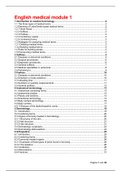English medical module 1
1 Introduction to medical terminology................................................................................2
1.1 The three types of medical terms......................................................................................2
1.2 Elements of Latin/Greek based medical terms..................................................................2
1.2.1 Word Roots.................................................................................................................... 2
1.2.2 Suffixes.......................................................................................................................... 2
1.2.3 Prefixes.......................................................................................................................... 2
1.2.4 Combining vowels.......................................................................................................... 2
1.2.5 Combining forms............................................................................................................ 3
1.3 Strategies for analyzing medical terms..............................................................................3
1.3.1 Defining medical terms...................................................................................................3
1.3.2 Building medical terms...................................................................................................3
1.4 Rules for building plurals...................................................................................................3
1.5 Pronouncing medical terms...............................................................................................4
2 Suffixes............................................................................................................................... 5
2.1 Diseases or abnormal conditions......................................................................................5
2.2 Surgical procedures.......................................................................................................... 6
2.3 Diagnostic procedures.......................................................................................................6
2.4 General suffixes................................................................................................................ 7
2.5 Medical specialities or personnel.......................................................................................8
2.6 Pertaining to...................................................................................................................... 9
3 Prefixes............................................................................................................................. 10
3.1 Diseases or abnormal conditions....................................................................................10
3.2 Directions or body positions............................................................................................10
3.3 Indicating time.................................................................................................................11
3.4 Numbers or quantity measurements................................................................................11
3.5 General prefixes.............................................................................................................. 12
4 Anatomical terminology..................................................................................................13
4.1 Anatomical combining forms...........................................................................................13
4.2 Anatomical position......................................................................................................... 13
4.3 Planes and sections........................................................................................................14
4.4 Directional terminology....................................................................................................14
4.5 Body surface terminology................................................................................................16
4.6 Body cavities................................................................................................................... 17
4.6.1 Divisions of the abdominopelvic cavity.........................................................................19
5 Dermatology..................................................................................................................... 19
5.1 Introduction..................................................................................................................... 19
5.2 Combining forms.............................................................................................................20
5.3 Organs commonly treated in dermatology.......................................................................20
5.3.1 Structures of the skin....................................................................................................20
5.3.2 Nail structure................................................................................................................ 21
5.3.3 Hair structure................................................................................................................ 21
5.4 Dermatology vocabulary..................................................................................................22
5.5 Dermatology abbreviations..............................................................................................24
6 Orthopedics...................................................................................................................... 25
6.1 Introduction..................................................................................................................... 25
6.2 Combining forms.............................................................................................................25
6.3 Commonly treated organs...............................................................................................26
6.3.1 Examples of three types of joints found in the body......................................................26
6.3.2 The skeleton.................................................................................................................26
6.4 Vocabulary...................................................................................................................... 28
6.5 Abbreviations..................................................................................................................31
6.6 Fractures......................................................................................................................... 31
Pagina 1 van 32
,1 Introduction to medical terminology
1.1 The three types of medical terms
Latin/Greek word parts: cardiology, tonsillectomy
Eponym: based on a person’s name ex. Alzheimer disease, Parkinson disease
Modern English words: MRI (magnetic resonance imaging), irritable bowel
syndrome
1.2 Elements of Latin/Greek based medical terms
1.2.1 Word Roots
= gives the essential meaning of the term. It tells you which part of the body, structure, organ
or system it refers to.
Word Root Meaning
Arthr Joint (gewricht)
Carcin Cancer
Cardi Heart
Cephal Head
Electr Electricity
Gastr Stomach
Hepat Liver
Myf Muscle
Oste Bone
Rhin Nose
1.2.2 Suffixes
= at the end
= most important part, it tells you what’s about
= always a suffix
1.2.3 Prefixes
= at the beginning
= abnormal conditions, numbers, positions or times
= not always a prefix
1.2.4 Combining vowels
= connect word parts & to make medical terms easier to spell and to pronounce
= placed between a word root – suffix or between two word roots
= aren’t used between a prefix- word root
Terms with combining vowels Meaning
Electr-o-cardi-o-gram Record of heart’s electrical (activity)
Hepat-o-megaly Enlarged liver
Oste-o-arthr-itis Bone and joint inflammation
Rhin-o-plasty Surgical repair of the nose
Aren’t always necessary:
Look at the first letter of the suffix. Don’t use a combining vowel between a word root
– suffix suffix begins in a vowel ex. Arthr-itis – Arthr-o-itis
Place a combining vowel between two word roots The second word root begins
with a vowel ex. Gastr-o-enter-o-logy – gastr-enter-o-logy
Pagina 2 van 32
,1.2.5 Combining forms
= consist of a word root & its combining vowel
= Isn’t another category of word part because it consists of two other word parts.
Op het examen, mag je kiezen, ofwel schrijf je word root + combining vowel of je schrijft
combining form !
Combining forms Meaning
Cephal/o Head
Rhin/o Nose
Hepat/o Liver
Cardi/o Heart
Gastr/o Stomach
My/o Muscle
Oste/o Bone
Arthr/o Joint
1.3 Strategies for analyzing medical terms
1.3.1 Defining medical terms
Follow these simple steps:
1. Divide the term into its word parts
2. Define each word part
3. Put the meaning of the word parts together in order to see what the term is describing
Ex. Dysmenorrhea
1. Dys/men/o/rrhea
2. Dys- prefix meaning abnormal, difficult, painful
Men/o combining form meaning menses, menstruation
-rrhea suffix meaning discharge, flow
3. Abnormal, difficult, or painful menstrual flow
1.3.2 Building medical terms
1. Selecting/choosing word parts that represent each portion of the phrase ex. Fibrous
skin tumour
Fibr/o combining form meaning fibrous
Dermat/o combining form meaning skin
-oma suffix meaning tumour, mass
2. Place the word parts in the correct order to complete the whole term ex.
Dermatofibroma
To gain a quick understanding of a term, it may be helpful for you to read from the end of the
word (Suffix) back to the beginning (prefix), and then pick up the word root. Ex. Endocarditis
Reads inflammation (itis); inner, within (endo); the heart (cardi). The complete term means
inflammation of the inner (lining) of the heart.
1.4 Rules for building plurals
If the word ends in Singular plural
-a, keep -a and add -e Vertebra vertebrae
-ax, drop -x, and add -ces Thorax Thoraces
Pagina 3 van 32
, -ex, drop -ex and add -ices Apex ( top of an organ) Apices
-is, drop -is and add -es Metastasis Metastases
-ix , drop -x and add -ces Appendix Appendices
-ma, keep -ma and add -ta sarcoma Sarcomata
-on, drop -on and add -a Spermatozoon Spermatozoa
-us, drop -us and add -i Alveolus Alveoli
-um, drop -um and add -a Ovum Ova
-x, drop -x and add -ges Phalanx Phalanges
-y, drop -y and add -ies Biopsy Biopsies
1.5 Pronouncing medical terms
Hints Examples
-ae or -oe, pronounce only second letter Bursae (BER-see)
Coelom (SEE-loam)
C and g have soft sound if followed by e, i, Cerebrum (ser – REE -brum)
or y Gingivitis (jin-jih-VIGH-itis)
C and g have hard sound if followed by Cardiac (CAR – dee – ak)
other letters Gastric (GAS – trik)
Ch- at beginning of word has hard k sound Cholesterol (koh-LES-ter-all)
Chemical (KEM-ih-call)
-e or -es at end of word pronounced as Syncope (SIN-koh-pee)
separate syllable Nares (NAIR-eez)
-I at end of word pronounced “eye” Bronchi (BRONG-keye)
Nuclei (NOO-clee-eye)
Pn- at beginning of word, pronounce only n Pneumonia (noo-MOH-nee-ah)
Pneumogram (NOO-moe-gram)
Pn in middle of word, pronounce hard p and Tachypnea (tak-ip-NEE-ah)
hard n Hypopnea (high-POP-nee-ah)
Ps- at beginning of word, pronounce only s Psychiatry (sigh-KIGH-ah-tree)
Psychology (sigh-KOL-oh-jee)
Pagina 4 van 32





